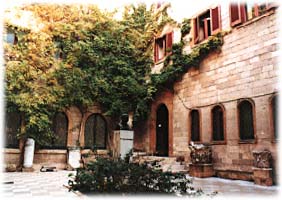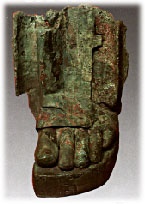 he Provincial Archaeological Museum is located in the historical centre of Brindisi. he Provincial Archaeological Museum is located in the historical centre of Brindisi.
It is a huge building, built up in the second half of the 50’s, close to the ancient porch of San Giovanni Gerosolomitano’s Knights. |
|
|
The Museum, pertaining to the Province, was opened to the public in 1956.
The new institution was born on the need to exhibit, more rationally, the archaeological finds belonging to the Civic and the De Leo Collections dating back to XIXth century till then kept respectively in the San Giovanni al Sepolcro’s Civic Museum and the Annibale De Leo Archiepiscopal Library, and of the Gorga’s Collection entrusted, in 1956, by the Ministry of Public Education to the new F.Ribezzo’s Archaeological Museum. |
|
|

The Provincial Library and the Provincial Education office were placed in the same building: at the end of the 50’s, a profitable and direct relationship between civic cultural institutions was set.
At the beginning of the 80’s, the Education Office and the Library were moved elsewhere, thus making possible an enlargement of the Museum.
The availability of new spaces gave the opportunity to conceive a structural and exposition project that was becoming urgent because of the acquisition of archaeological materials recovered during excavations made in Brindisi and in the surrounding territory as well as of the purchase of the Marzano’s collection.
Thanks to new and modern didactical and museum criteria, the Civic, De Leo, Marzano and Gorga’s Collections have been reorganized and distinguished from the finds coming from excavations showing the history of the town and of its own territory, starting by the most ancient prehistorical settlements up to the Middle Ages. |
|
|
The visitor is then offered three different visits:
- The epigraphic and statues’ section
- The historical collections
- Brindisi and its territory
The first visit is very interesting, starting from the entrance-hall where some stelae, inscriptions and sculptures belonging to the roman period are there arranged, going through the underground where epigraphs and statues found both in town and in the pertinent territory, are located.
The second visit which develops between the ground-floor and the second floor, shows the historical collections of the Museum.
The reading proposed for the historical collections is essentially typological, for it deals with material coming from the purchase made on antiquarian markets or belonging to the recovery of occasional finds, having no archaeological context, that’s having no news concerning the circumstance and the place of the finding.
The third visit including the archaeological finds coming from Brindisi and its province, arranged according to chronological criteria, is nowadays still in a project phase, for the only section carried out is the Prehistorical Section.
At present, planning studies concerning the restoration and the adaptation of wide rooms on the ground-floor which will allow the use of exhibitive spaces for the Underwater Archaeology Section are in progress. Here, the plentiful archaeological material recovered during the excavations made by the Museum, along the Brindisi coasts from Egnazia till Torre Mattarelle started on 1972, will find its suitable location. |
|
|
Bronze foot belonging to the roman imperial age
|
|
 To the stone and lead anchor stocks, to the several transport amphorae, the plentiful table pottery and in particular the bronze foot belonging to a feminine statue of 51 cm long, it will be added all the several fragments of bronze statues recovered during the recent excavations of underwater archaeology of Punta del Serrone: two male torsos, one having drapery, male and female naked or with drapery limbs, the arms having the fingers adorned with rings, the legs having the feet naked or with boots, winding drapery and seven heads belonging to decorative and honorary sculptures dating back to a period between the IVth century B.C. and the IIIrd century A.C. To the stone and lead anchor stocks, to the several transport amphorae, the plentiful table pottery and in particular the bronze foot belonging to a feminine statue of 51 cm long, it will be added all the several fragments of bronze statues recovered during the recent excavations of underwater archaeology of Punta del Serrone: two male torsos, one having drapery, male and female naked or with drapery limbs, the arms having the fingers adorned with rings, the legs having the feet naked or with boots, winding drapery and seven heads belonging to decorative and honorary sculptures dating back to a period between the IVth century B.C. and the IIIrd century A.C. |
|
|
Bronze portraits found in Punta del Serrone
|
|
  
|
 
|